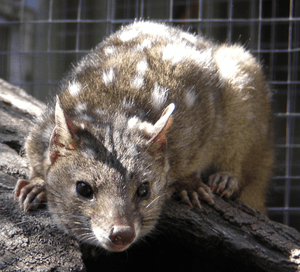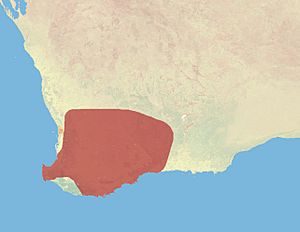Western quoll facts for kids
Quick facts for kids Western quoll |
|
|---|---|
 |
|
| A western quoll at Caversham Wildlife Park, Western Australia. | |
| Conservation status | |
| Scientific classification | |
| Genus: |
Dasyurus
|
| Species: |
geoffroii
|
 |
|
| Western Quoll range | |
The western quoll (Dasyurus geoffroii) is a special animal found only in Western Australia. It is the biggest meat-eating mammal that lives there. This amazing creature is also known as the chuditch. It is a type of marsupial, which means it carries its babies in a pouch, just like a kangaroo. Right now, the western quoll is considered a near-threatened species. This means its numbers are getting low, and it needs our help to survive.
Contents
About the Western Quoll's Name
The western quoll belongs to a family of animals called Dasyuridae. It is closely related to the bronze quoll, which lives in New Guinea. The scientific name for the western quoll is Dasyurus geoffroii. The "geoffroii" part comes from a famous French scientist named Étienne Geoffroy Saint-Hilaire. He was the one who named the group of animals called Dasyurus back in 1796.
In Western Australia, people often call this animal the chuditch. This name comes from the Noongar language, spoken by Indigenous Australians. The word "chuditch" can be used for one animal or many. Other names for the western quoll include atyelpe, chilpa, kuninka, and idnya. Long ago, some people also called it the "western native cat."
What Does a Western Quoll Look Like?
A western quoll is about the same size as a pet cat. Its fur is a reddish-brown color. It has between 40 and 70 white spots on its back. Its belly is a creamy white. These spots help the quoll hide at night when it is hunting. They make it harder for prey to see its shape against the moon.
The quoll has five toes on its back feet. Its head and body are usually about 36 to 46 centimeters long. Its tail is a bit shorter, around 22 to 30 centimeters. Western quolls have big eyes and pointy ears. These features help them see and hear well in the dark. A black, bushy part covers the last half of its tail. Male quolls are a bit heavier, weighing about 1.3 kilograms. Females are lighter, usually around 0.9 kilograms. Western quolls usually live for about four years.
Sometimes, people confuse the western quoll with the eastern quoll. But the western quoll has a first toe on its back foot, which the eastern quoll does not. Also, its tail is darker. Like the eastern quoll and northern quoll, it has a brown coat with white spots and a long tail.
Where Do Western Quolls Live?
Long ago, western quolls lived across most of Australia. They were found in about 70% of the continent. But after Europeans settled in Australia in the late 1700s, their numbers dropped a lot. Now, western quolls only live in the very southwest part of Western Australia.
They like to live in wet and dry sclerophyll forests. These forests include places like the Jarrah Forest and mallee areas. These habitats have open forests, woodlands, and open shrublands. Sometimes, they are seen in the Wheatbelt and Goldfields regions of Western Australia. However, they completely disappeared from the Swan Coastal Plain by the 1930s.
Western quolls need a lot of space to live because they are meat-eaters. Their home areas often include rocky ledges and other open spots. These places help them mark their territory and meet other quolls. Male quolls have very large territories, about 15 square kilometers. A male's territory usually overlaps with several female territories. Female territories are smaller, about three to four square kilometers each. Females do not share their territories with other females. Most female home ranges have about 70 hollow logs and 110 burrows they can use as dens.
Western Quoll Behaviour
The western quoll is a solitary hunter. This means it usually lives alone. It is mostly a ground-dwelling animal and is active at night. It hunts most often around dusk, which is when it is crepuscular. Western quolls move quickly on the ground. They are also good at climbing trees. They can dig their own burrows or use burrows that other animals have made. During the day, they rest in hollow logs or burrows. They even lower their body temperature while they sleep to save energy.
Western quolls are at the top of their food chain. This means they need a lot of food and a healthy environment to survive. Since they are carnivores, they eat large insects and any small animals they can catch. Their diet includes lizards, birds, frogs, spiders, and small mammals. The biggest animals they will eat are about the size of a bandicoot or a parrot.
In places where western quolls have been brought back, they have been seen eating rabbits and burrowing bettongs. They mostly hunt on the ground. But they will climb a tree to get a bird's egg. When they catch larger prey, they kill it with a bite to the back of the head. Western quolls can get most of the water they need from their food. This is very helpful, especially during dry times.
Reproduction and Life Cycle
Western quolls are seasonal breeders. This means they only mate during certain times of the year. They usually mate between late April and July, with most mating happening in June. During this time, female quolls protect their territory very strongly. Their territories can be quite large, from 55 to 120 hectares. Male and female quolls only meet to mate.
Most female quolls have litters of two to six babies. Sometimes, more babies are born than the mother can care for. The mother carries her babies in a shallow pouch for 16 to 23 days. After about seven to fifteen weeks, the young quolls grow too big for the pouch. Then, the mother leaves them in the den while she goes out to find food. The young quolls stop drinking their mother's milk at 23 to 24 weeks old. They become independent at 18 weeks and can have their own babies when they are one year old. The young quolls leave their mother's territory in November to find their own homes.
Why Western Quolls Are Declining
The number of western quolls has gone down for many reasons. Clearing land for farms and buildings is one big problem. Fires that are not managed well also hurt them. Farmers using chemicals called pesticides can harm them too. Animals like cattle and wild herbivores eating their food also cause problems.
Other dangers include illegal hunting, accidentally falling into water tanks and drowning, being hit by cars, getting caught in barbed wire fences, and being poisoned. Wild cats, called feral cats, are a huge problem. They hunt quolls and also compete with them for food. As more land becomes unsafe, western quolls are forced to move to new places.
The Australia Wildlife Conservancy (AWC) helps protect western quolls at Paruna Sanctuary. They have a program to control wild predators like feral cats and foxes. They use traps and baits to keep these animals away.
Bringing Western Quolls Back
People are working hard to bring western quolls back to parts of Australia where they used to live.
In April 2014, a five-year project started to bring western quolls back to the Flinders Ranges in South Australia. About one-third of the first quolls released were lost, mostly because of feral cats. But most of the female quolls that survived had babies. Sixty young quolls were born! As of May 2016, 15 more quolls from Western Australia were released in the Flinders Ranges. This brought the total population there to 150 quolls. About half of these quolls were born in the Flinders Ranges. Scientists plan to keep watching this group for two more years. The Foundation for Australia's Most Endangered Species (FAME) is also helping to bring the western quoll back to this area.
Western quolls have also been brought back to the dry areas of South Australia. A group of them now lives at the fenced Arid Recovery Reserve near Roxby Downs.
There are also plans to bring western quolls to other places. These include Dirk Hartog Island in Shark Bay, Mount Gibson Sanctuary in Western Australia, Wardang Island and southern Yorke Peninsula in South Australia. They also plan to release them in large fenced areas in the Pilliga Forest, Mallee Cliffs National Park, and Sturt National Park in New South Wales.
Zoos also help by breeding western quolls. Perth Zoo has provided some animals for these release programs.
See also
 In Spanish: Cuol occidental para niños
In Spanish: Cuol occidental para niños



